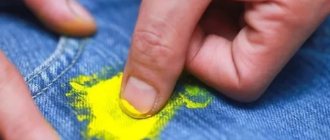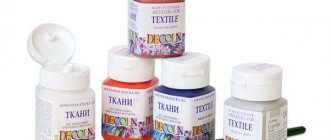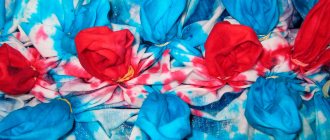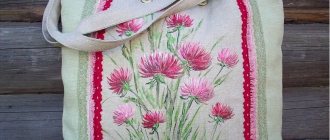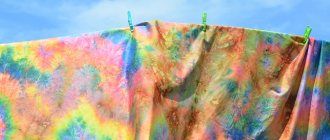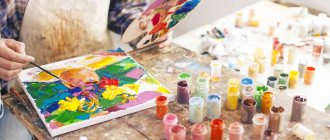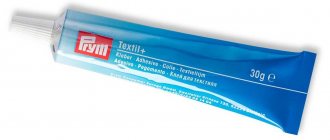How to dye fabric with green paint?
Good old green stuff
- Dissolve a small amount of green pharmacy liquid in warm water. ...
- Stir the entire contents of the container evenly.
- After this, place a damp cloth or T-shirt there.
- Let stand for 20-30 minutes.
12 Dec.
2022 Interesting materials:
How to find out the UIN code for a payment order? How to find out when SNILS was issued? How do you know when a chicken starts laying eggs? How to find out when child benefits will be accrued? How to find out when Snils was issued? How do you know which egg will hatch into a chicken or a rooster? How to find out who is connected to Wi-Fi? How to find out where the funded part of the pension is deducted? How do I know where to send the writ of execution? How to find out who Snils is registered to?
Types of paints
Progress is moving forward rapidly. Manufacturers offer a wide range of fabric paints, differing in their properties and application possibilities. The forms of pigment release are also varied. The most common: paint in jars, tubes, aerosols, powder in bags. Paste and powder forms most often require additional preparation before application, while liquid and aerosol forms do not require such preparation.
There are two large groups of fabric paints on the market:
- for silk, the packaging is marked “Silk”;
- for textiles, are marked “Textil”.
As the name suggests, paint labeled “Silk” is suitable for painting and dyeing silk, but it can also be used on thin cotton fabric. It is used together with a reserve contour, which is used to create the outline of the design, since the paint itself is very liquid.
Silk paints are characterized by high fluidity and transparency; with their help, the boundaries of the design are smooth, and you can create magnificent patterns. An interesting effect is achieved by using acrylic paints together with salt.
Mixed technique, knotted, multi-layered or hot batik - this is just a small list of techniques where silk pigments are actively used.
Textile paints are thicker, have a high density, they are easy to paint over large areas, they do not spread, and do not require the use of contours.
Textile paints are actively used for applying prints to dresses, jeans, T-shirts, pillows, and interior items. Products using the stencil technique look very interesting, and the most popular is the free-form painting technique, which is reminiscent of conventional drawing.
Manufacturers offer a large selection of paints for textiles: with a metallic effect, neon, with glitter, for light or dark textiles, etc.
An important characteristic of a pigment is the way the dye is fixed. There are two types of dyes on the market:
- fixed under high temperatures;
- fixed under the influence of steam.
For beginning needlewomen, it is better to choose dyes that are fixed by heating, since using an iron is much easier than using special steaming devices. The fixing process itself is necessary so that the paint stays on the fabric for as long as possible, does not stain other things when washed, and also retains its color under the influence of ultraviolet rays.
Acrylic paints for fabric
Acrylic paints for fabric are created on the basis of artificial resins, are water-soluble, and completely safe for humans. They are in constant high demand among painting lovers and have a number of undeniable advantages. Acrylic dyes are ready for use and are available in various forms: jars, tubes, aerosols. Acrylic paints come in matte, glossy, pearlescent, with the addition of glitter, luminous, neon or metallic.
Acrylic dyes are used for both silk and cotton fabrics, viscose, wool, linen, synthetics, and mixed materials.
Acrylic is universal in use; it is used for painting T-shirts and bags. tablecloths, napkins, scarves. However, acrylic paints are not recommended for painting items that are washed frequently, as the paint will fade and wear off over time. This category includes bed linen and children's clothes. We also do not recommend painting children's things with acrylic paint due to the risk of a child having an allergic reaction to the dye, especially in children of primary preschool age.
Acrylic dyes can be used to paint outerwear (jackets, raincoats) and shoes. It is moisture-resistant and frost-resistant - things become resistant to rain, snow and other adverse natural phenomena.
Acrylic paints do not have a pungent odor and dry quickly. Another plus is the ability to choose unusual shades: turquoise, lemon, ultramarine and others. The paints mix well with each other, giving needlewomen the opportunity to create their own unique color.
Acrylic paints are universal; they are suitable for application with a brush, foam swab, and for painting using the printed or stencil technique.
In batik, acrylic paints are used only together with a reserve contour, which fixes the edges of the design so that the paints do not mix with each other.
Choose acrylic paints for fabric
Aniline dyes
Aniline dyes have been firmly occupying their place on the market for many years and are available in powder or liquid form. When working with powder, it is necessary to take precautions and avoid getting powder particles into the respiratory tract, since aniline is very dangerous. However, after being applied to textiles, the paint loses its toxic properties and becomes completely safe for human health. The advantage of aniline dyes is that they give bright, rich colors to the fabric. Paints can be combined with each other to create unique shades.
Aniline dyes have restrictions on the composition of the fabric - they can only be used on natural fabrics (cotton, linen, silk, etc.).
Aniline dyes have proven themselves well for use in the gradient technique. Its essence lies in the fact that the product is gradually immersed in water of a certain temperature so that part of it turns a darker color, while the other part remains lighter. You can get a streaky effect if you twist the product with your hands for a short time.
Aniline dyes are often used for painting decorative items or creating paintings. A special feature of aniline dyes is that the product must be steamed for the dye to adhere to the fabric. This procedure requires some experience; inattention can lead to marriage.
When working with aniline paints, it is best to use soft brushes. Aniline spreads well, so it is used to create designs that do not have clear outlines. If it is necessary to highlight contours, then two main methods are used:
- Tragantine glue is added to the paint in a ratio of one to three;
- the fabric is primed with a special gelatin-based composition.
Aniline dyes are convenient to work on any fabric. They dry long enough, so the craftswoman has time to correct flaws in the drawing. If the resulting pattern turns out to be too bright, it can be easily lightened by applying a small amount of water to the fabric.
Choose a fabric dye
Plastisol paints
Innovative dyes include plastisol-based dyes used for various types of fabric, including 100% synthetics. Plastisol paints can be used on any fabric, even the heaviest (suede, denim, matting). They form a special moisture-proof film on the fabric, reminiscent of rubber in appearance.
Plastisol is part of reflective and luminous paints. They are used to apply luminous patterns on outerwear, shoes, and sportswear. Paints may be invisible during the day, but at night, when exposed to light or ultraviolet rays, they become green, yellow, pink or white.
It is important to remember that for plastisol paint to dry, it is necessary to provide a temperature of 140-1600 C; at a lower temperature, the paint does not dry.
Plastisol paints are easy to use, are sold ready-made, and do not require dilution or other preliminary preparation.
Stamp inks
Stamp inks are a universal type of dye used for various types of textiles. The pigment is most widely used in hotels and hospitals - it is used for marking on bedding, towels and other fabric products. They are highly durable and resistant to high temperatures. In particular, items dyed with alcohol-based dyes may be subject to boiling and bleaching. Water-glycerin-based stamp inks dry quickly and do not stick to your hands, but the maximum washing temperature is already 70 degrees.
Interesting are colorless paints that are invisible under normal lighting. Area of application - application of hidden markings, which appear under the influence of ultraviolet rays.
VAT paints
The pigment is produced in the form of paste or powder, the main feature is water insolubility. Most often, vat dyes are used to dye embossed fabrics, such as wool. However, yellow and orange pigments accelerate the process of destruction of fabric from ultraviolet rays, so paint should be used with caution on those things that will be actively exposed to the sun.
Natural dyes
Natural dyes have been used by people since ancient times, but in terms of their consumer properties they are significantly inferior to synthetic dyes - the result of dyeing can be unpredictable, and the resulting color will quickly lose its brightness.
The advantage of natural pigments is their environmental friendliness and the possibility of use by people prone to allergic reactions to synthetic dyes.
Natural dyes include coffee, onion peels, fir cones, oak bark, cinnamon, black tea, from which a brown pigment can be obtained. Indigo comes from a mixture of turmeric and spinach, while purple comes from beets.
The scope of application of fabric paints is very wide. Painting clothes and shoes will allow you to find your own exclusive style. Fabric paintings, tablecloths, lampshades and pillows, made using various painting techniques, will create unique comfort in your home, and the process itself will certainly bring pleasure.
View all paints and contours for fabric painting
How to make sure that gouache does not wash off with water?
Gouache
– water-soluble paint.
If you applied this paint to a surface that will be exposed, for example, to moisture, then so that the gouache does not wash off
, it can be varnished.
Interesting materials:
How to choose the color of the baseboard to match the color of the laminate? How to choose the color of the floor of doors and skirting boards? How to choose the floor color for the doors? How to match the ceiling color to beige wallpaper? How to choose the color of the cabinet in the hallway? How to choose the color of curtains for the living room? How to choose the color of the curtain? How to choose the color of the walls in the living room? How to choose the color of the walls in the living room? How to choose the color of the walls in the rooms?
Main options
- Acrylic compounds
- Drawing pencils
- In cans
Spray cans and pencils are easy to apply, but painting with acrylic paints is not that difficult. Both a professional and a beginner who, for the first time in his life, decided to decorate his favorite T-shirt with his own hands, can cope with them. Come to a specialized store and ask the seller for help in choosing - he will tell you which composition is better, simpler and at the same time cheaper.
Is it possible to paint with gouache on a T-shirt?
How can you
dye
a T-shirt
?
The first thing that comes to mind is fabric dyes. But if they are not at hand, then ordinary gouache
.
Interesting materials:
Is it possible to give puppies dry food? Is it possible to give the mixture after three weeks from the date of opening? Is it possible to give nimesil to a dog? Can I give my dog painkillers? Is it possible to give your dog treats? Is it possible to give zakat to one's brother? Is it possible to keep the power supply plugged in? Is it possible to keep a guinea pig in the sun? Is it possible to keep a husky puppy outside? Is it possible to keep a female and a male betta in the same aquarium?



